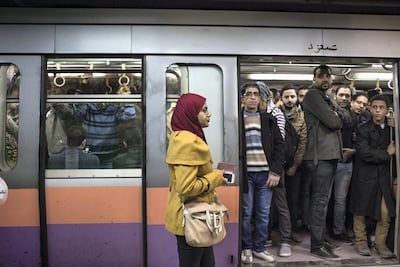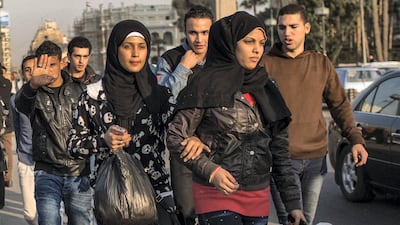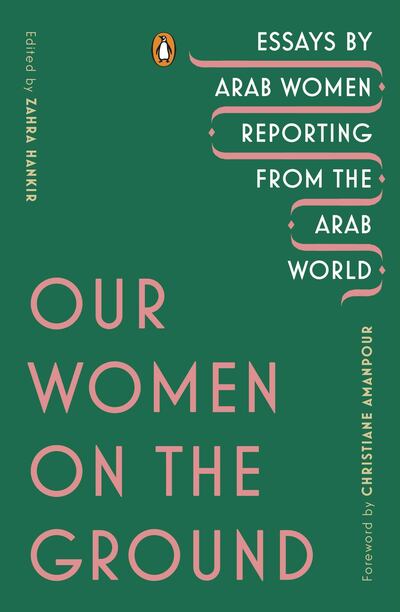Jane Arraf's essay, Maps of Iraq, opens in Baghdad on "a lovely spring morning in 2004". Arraf, who was CNN's senior Iraq correspondent at the time, is out covering the annual Shiite pilgrimage to the Kathimiya shrine in the north of the city.
“I remember saying out loud that nothing bad could possibly happen on such a beautiful day,” she writes. Soon after, Arraf hears the sirens of ambulances and sees the bodies of the dead and the wounded being whisked away from the sacred site, which has been attacked by three suicide bombers. “We walked toward the shrine, even as people ran from it.”
Perhaps we shouldn't be surprised by that last line. Reporting the story, however dangerous that might be, is what journalists like Arraf do. We encounter this courage throughout Our Women on the Ground, a remarkable collection of 19 original essays written by Arab women who have reported from the Arab world, often in life-threatening situations.

There is Zaina Erhaim, who spent two years working inside the rebel-held area of Aleppo. "During those years, barrel bombs were toying recklessly with my existence," she writes in Hurma. Or Asmaa Al-Ghoul, who reported on the Israeli invasion of Gaza in 2006. "I went straight to the front lines," she writes in Between the Explosions, "where bullets whizzed by my ears, without a bulletproof vest or any other form of protection afforded to foreign news crews."
But we are surprised when we read these essays. Why is this? Could it be that the behaviour of these Arab women confounds the expectations placed on them by society? Zahra Hankir, the Lebanese-British journalist who edited Our Women on the Ground, alludes to this in her introduction.
“On one hand, an Arab woman may be victimised or pitied by outsiders who think her to be ‘submissive’, ‘oppressed’ or ‘subjugated’,” writes Hankir. “On the other hand, an outspoken Arab woman is sometimes deemed improper, or an anomaly, by both outsiders and the society around her. Professionally, she might be considered less of a ‘threat’ than her male peers, not taken seriously. And she is sometimes actively silenced or passively unheard.”
Our Women on the Ground is Hankir's attempt to "disrupt such flimsy stereotypes". As she explains from New York: "I hope to evoke how layered the Arab world is through the stories of these women and their experiences."
Although this collection spans many decades – Financial Times deputy editor Roula Khalaf's wonderful essay, Dying Breed, touches upon the insurgency in Algiers in 1995 – its genesis is the Arab uprisings of 2011. The eyes of the world were on the Middle East and Hankir, who was working for Bloomberg News in Dubai at the time, quickly realised that some of the best reporting was being done by local, Arab women. "And yet," she says, "they weren't garnering as much attention as their western counterparts, who were unsurprisingly commanding the international media narrative on the rapidly deteriorating situation.
"I wanted to learn more about these women and their stories. So often, western reporters will cover the region for a year or so, go back to their home countries and then write about their experiences in memoirs or authoritative non-fiction books. I reasoned: what about these Arab women journalists? What if we read about their experiences and the steep and unique set of challenges they face to do their jobs, and about how their lives have been affected by the tumult in the region, in a similar publishing space?"
Our Women on the Ground gives that space to some of those stories forgotten or simply passed over by the international media. "The Arab women journalists in this book demonstrate why it's important to include more native accounts in mainstream media narratives as we seek to better understand the region and its many nuances," says Hankir.
In Egyptian photographer Eman Helal's essay Just Stop, for example, we read about the women who gathered at Tahrir Square to celebrate International Women's Day only a few weeks after Hosni Mubarak had stepped down as president of Egypt.
“A group of men suddenly approached us, saying we needed to go home because ‘we didn’t belong outside’,” writes Helal. “Then some of the men started to physically attack us […] I was terrified, but managed to take a few pictures in those few seconds before breaking into a run along with the other women.”
It is not only the stories themselves that matter, though. It is also the struggles faced and sacrifices made by these women to tell them. Helal's experience in Tahrir Square persuaded her to launch a photography project about sexual harassment in Egypt. "Few people in the newsroom supported my project," she writes. "In fact, many of my male colleagues mocked me for it."
For Yemeni photographer Amira Al-Sharif, picking up a camera was a radical act in itself. "Had I gotten married as a younger woman, I would have been expected to rely on my husband and to focus on raising a family, not on pursuing a career," she writes in her essay, Yemeni Women with Fighting Spirits. "I defied those societal expectations. Being unwed is the price I have paid for my professional life."
There is another side to this as well, of course, which Our Women on the Ground illustrates beautifully. In many cases, and certainly not only during the Arab uprisings, these stories gain their power precisely because they are told by women. They have access to spaces men do not, such as women's-only quarters in mosques or gynaecological clinics. "This allows them to tell fuller and more nuanced accounts of war and its devastating consequences, particularly on women," says Hankir. "Many of the contributors, realising that they might not be able to navigate male-dominated spaces without facing sexism or misogyny, turned their attention to women and telling women's stories by seizing upon that advantage."
Hannah Allam's essay The Woman Question, which opens the collection, shows us that many of the real stories of war are told away from the bullets and the bloodshed. Allam, who served as the Baghdad bureau chief for US publishers McClatchy during the Second Gulf War, remembers being labelled as "soft" for focusing on the lives of those people – invariably women – who were not involved directly in fighting. The absurdity of this is not lost on her.
“Reporting on Iraq through the eyes of its women was illuminating,” she writes, “but, perhaps more important, it was more representative of the population as a whole. Years of bloodshed had left Iraq with a population that was more than half women, many of them heads of households because their men were dead or missing or exiled.”
Our Women on the Ground offers a perspective of the Arab world too often not heard above the "bang-bang" of conflict. Which does not mean the accounts aren't harrowing. The events endured by women during war are often the most harrowing. Some of the essays in Our Women on the Ground are hard to read, so unsparing are the details. It is worth returning to Al-Ghoul's essay Between the Explosions, in which she describes the aftermath of an Israeli attack on Rafah in Gaza. "I went into another room, where a distraught and hysterical mother was wailing," writes Al-Ghoul. "She asked if I had come across a baby dressed in pink – the dead baby on the floor that I had just seen." The woman collapses and Al-Ghoul describes how, in that moment, she was no longer merely a journalist – she "acted like a mother".
“I wanted them to speak freely about whatever experience they felt was most important to them and whichever they felt most comfortable writing,” says Hankir. “I didn’t coach or coax the women to write any particular story and didn’t project any particular themes on to them. Understandably, some of the women were still experiencing or coming to terms with trauma or grief given what they’d personally experienced or witnessed on the field.
"I hoped that the women would delve into how they felt about what they were witnessing or had witnessed, rather than what they were simply witnessing. I also hoped for raw and intimate accounts, with moments of light, resilience and gallows humour – and the women certainly delivered on all fronts."
Our Women on the Ground: Arab Women Reporting from the Arab World is out now, published by Harvill Secker



